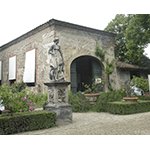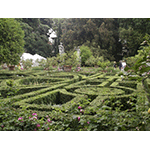Palazzo Corsini al Prato Garden
Adjoining the palazzo designed and begun by Bernardo Buontalenti in the late 16th century for Alessandro Acciaioli, the garden was completed on a plan by Gherardo Silvani in the following century. Originally conceived to apportion greater space to the experimental cultivations of Acciaioli, a great lover of botany, it was transformed into an Italian garden when it became property of Filippo di Lorenzo Corsini in 1621. Still today, the garden is divided into two parts by a lane lined by a series of statues on bases that gradually decrease in height, so as to give the perspective view an effect of greater depth. The regular shaped beds are made up of box hedges and decorated with potted citrus trees. At the end of the 16th century, Agostino Del Riccio reported the presence of one of the first examples of "bamia" or arboreal althaea (Hybiscus syriacus).
In the early 19th century, Antonietta Waldstatten Corsini transformed part of the English garden by realising a small hill, a lake, and several small woods traversed by winding paths. In addition to the Italian garden flower-beds, there are two lemon-houses for sheltering the potted citrus trees and a "carro matto", a wooden instrument for raising and transporting vases. The garden also has a lawn with century-old linden trees and a vegetable garden-orchard, which is one of the few testimonies of agricultural areas inside the city.
The garden has recently been subjected to rehabilitation by Olivia di Collabiano who chose the flowers and aromatic plants for the flower-beds. It is today one of the richest and best conserved historical gardens of Florence.
As of a few years now, in the middle of spring it hosts the exhibition, "Handicrafts and Palazzo".
****************************
Texts by Graziano Magrini
English translation by Victor Beard
Last update 26/mar/2008





